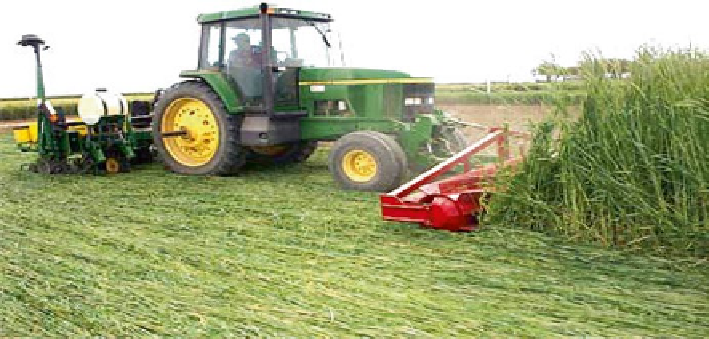Agriculture Reference
In-Depth Information
Fig. 8.13
Roller-crimper in front of a tractor for no-till seeding into a cover crop. The metal strips
on the roller drum crimp the stems. They should not cut or chop the stems (Courtesy of I & J
Manufacturing, Gap, Pennsylvania)
and leaves is and remains exactly in the direction of travel. This condition is achieved
by flattening out the cover crop on the soil via rolling and crimping precisely in the
seeding direction
(Fig.
8.13
).
Hence no residue parts are present, which are oriented at random and because of this
can cause blocking. Since the plants still are fixed to the soil by their roots, by and large
they remain in their place and are not taken along with the machinery. With tall cover
crops, it is recommended to use row-cleaners in front of the seeding-units as well.
Since precise orientation of the flattened plants is very important, rolling and crimp-
ing cannot solve the problems for no-till seeding, if a cover crop lodges in several direc-
tions. However, with well managed cover crops this hardly occurs. So the roller-crimper
technique provides new perspectives for no-till methods after cover crops.
However, the agronomic prerequisites of cover crops still remain. These are
firstly the extra water supply for a crop instead of a fallow period within the rotation,
and secondly the need to fit this crop into the seasonal schedules of the main crops.
In areas that are short in water supply, the first prerequisite cannot be come up to.
And if the second prerequisite - maintaining the seasonal schedules of the main crops
within the rotation - cannot be met, yield losses with these can result. So seeding
into cover crops still needs to be well adapted to the existing conditions.
8.4.3
Seeding and Loose Residue Sizes
Loose residues from the previous crop can affect the emergence in two ways
•
by deteriorating the precision of the sowing depth
•
by impeding the water transfer from the soil to the seeds.

